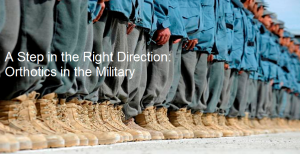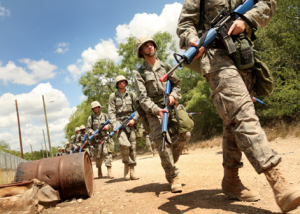Hey everyone,
I decided to do my project on the use of custom orthotics in the military population during my mid-education crisis. As many of you know I have always been interested in pediatrics but I also enjoy the orthopedic realm. My second clinical rotation was completed at the VA in Salisbury from which I became interested in the military and possibly seeking an active duty career. I did some research into where physical therapists may be able to make a difference in this population and found that many injuries occur during basic military training. Therefore, inspired by our Health and Wellness class, I decided to do my project on the use of custom orthoses for the prevention of injury during basic military training. To expand the topic this past semester I researched the use of custom orthoses to treat injuries as well.
My capstone project includes the two evidence tables from my research topics, orthoses for prevention and treatment of injuries. The prevention table is specific to the military population but the treatment table includes many different populations although mostly highly active individuals. My project also includes four educational handouts. The first three are meant for the education of physical therapists. I decided on this route because I did not know much on research behind orthoses. I wanted to make materials that would give physical therapists confidence in using this type of intervention by explaining the mechanism of action and the current research. Therefore these three are almost like a series: prevention, treatment, and an in-depth review of specific conditions.
The last handout is meant for potential military recruits given prior to starting basic military training (during the recruitment process or at their physicals). The handout provides basic information about injury rates, what orthoses are, how to obtain them, and how they can help in case of injury. Common problems with adherence to orthoses are addressed in the recommendations section. A list of medical conditions that can be treated with orthoses are given as a reference for recruits.
Because my topic was so educationally based and relies heavily on reading, I will include all four health literacy assessments that I completed on my documents (sam forms- prevention, treatment, in-depth review, and recruit). All but one of the materials ranked as the highest level on the assessment; I realize now that I could have made them more interactive. This was a difficult task for me to complete with the first three handouts because the audience was physical therapists not patients. The last assessment for the recruit education handout was a lot more straight forward. I performed these assessments at mid-term and have made slight adjustments to the materials since then.
I had two amazing committee members for this project, Bob Stone and David Banks, both whom have worked in the military environment. Bob Stone was my clinical instructor at the VA in Salisbury. He had worked as a hospital corpsman in the Navy and took care of a lot of feet. David Banks had a career as a Marine officer. After retiring, he worked with a defense contractor and provided insight on many developing military projects. I received both candid feedback from my advisers as well as had them fill out a simple evaluation form of the materials.
Lastly, for anyone interested, I will post relevant materials from other classes. From Evidence Based Practice II, I will post my final paper that reviews the current literature on custom orthoses for the prevention of overuse injuries during basic military training. At the end of this paper I make suggests on how to further research in this area. I will also post my Health and Wellness final assignment: “Feet First.” The project was a program designed to identify individuals at risk for lower extremity injury and provide them with the correct amount of foot protection/support.
Thanks everyone that has helped me through this process!
Mandy











8 Responses to “A Step in the Right Direction: Orthotics in the Military”
Mandy
Hey Mike,
I wondered whether I should cut back the number of diagonses on the list and provide the ‘common’ names or a general description for the major players. I will keep that in mind for future revisions. Thanks.
Mandy
Mike Gross
Mandy- very good job on this. My only recommendation would be that the handout for the recruits should have additional information to help them know whether or not they have any of these musculoskeletal conditions. for patellofemoral pain syndrome you could have had (kneecap pain) in parentheses, as an example. Mike
Mandy
Hey Mike,
Thanks Mike, that really means a lot to me especially coming from our ortho guy! The treatment handout was my favorite as well. For many of those conditions there are not many good RCTs studying the effects of orthoses. Only two conditions actually had meta-analyses or reviews completed on them. I tried to provide the best investigation I could for each of the lower extremity conditions. Hopefully they give you some treatment ideas or evidence to support your clinical decisions. Thanks again.
Mandy
Michael Essa
Mandy, This project was outstanding! Your handouts looked great and the information in them was excellent. I especially enjoyed the breakdown of orthotic use for each condition (in the treatment handout). I’ve already downloaded all your handouts and plan on holding on to them for use in the clinic. Great Job! ME
Mandy
Hey Sadye,
Yes the project seemed to spinning wildly out of control there for a moment! There was just so much that I wanted to put out there. I tried to make the series flow together and look cohesive. My Committee advisor David Banks gave me ideas on how to further my literature idea even more by looking into current Research and Development projects in the military; where they may be working on this issue. Seems like there is always another step!
Mandy
Mandy
Hey Kathryn,
I had discussed that issue with my committee advisor David Banks. He thought that the best time to catch recruits, and give them this handout, would be during the recruitment process through their recruiter. The recruiter puts a lot of time and effort to have his potential recruits ready for basic training including the physical aspect. Therefore having an open discussion with the potential recruit about appropriate footwear and prevention may lead to healthier feet entering basic training. The issue that we discussed with this plan is that, without supervision or enforcement, that orthotics will likely be put aside by potential recruits. Thanks for the comment!
Mandy
Sadye
Mandy, it is SO great to see how far this idea has evolved! And I really love the style for the PT handouts – kind of like a magazine. Very creative, well organized, and super informative. Excellent work!
Kathryn
Mandy, What a great idea! I especially appreciated the handout for military recruits about hot to wear orthotics as a preventative measure. Is there a plan for how to distribute these handouts to the recruits? After hearing Goss talk about how valuable orthotics are to the military, especially considering the extra amount of weight carried during training and combat, I think it is a great idea to educate people BEFORE they begin training!
Great project!!